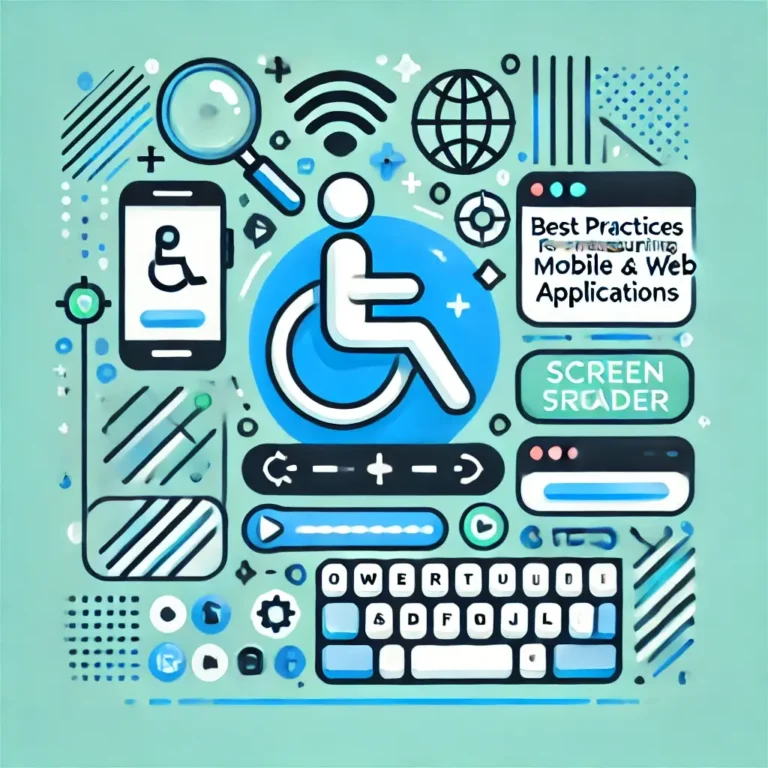
Best Practices for Ensuring Accessibility in Mobile and Web Applications
In today’s digital age, ensuring accessibility in mobile and web applications is not just a nice-to-have feature but a necessity. With increasing numbers of users relying on digital platforms for everyday tasks, developers and designers must prioritize accessibility. Doing so ensures that everyone can effectively use and navigate these applications regardless of ability.
To help you create inclusive and accessible mobile and web applications, here are some best practices to keep in mind:
Use Semantic HTML to Ensure Accessibility in Mobile and Web Applications
Structuring your code with semantic HTML elements enhances SEO and overall code quality while also helping screen readers and other assistive technologies accurately interpret and navigate your content. Semantic elements like <header>, <nav>, <main>, and <footer> provide clear context for the structure of your webpage, making it more accessible.
Pegotec’s Approach to Semantic HTML
At Pegotec, we ensure that all our web projects are built with semantic HTML to enhance accessibility. Using well-structured code makes our applications more navigable for users who rely on assistive technologies.
Provide Alternative Text for Images
Including descriptive alt text for images is crucial for visually impaired users who rely on screen readers to understand the content. Ensure your alt text is concise and specific, clearly describing the image’s content or purpose.
How Pegotec Implements Alt Text
We prioritize the inclusion of descriptive alt text in all our projects. This not only makes our applications more accessible but also improves the overall user experience by ensuring that all users, regardless of ability, can fully understand the content.
Ensure Keyboard Accessibility
Not all users can navigate applications using a mouse or touchscreen. To accommodate these users, ensure that all interactive elements—such as buttons, links, and form fields—are accessible and navigable using a keyboard. This involves providing logical tab orders and ensuring that all interactive elements are focusable and operable via keyboard input.
Pegotec’s Focus on Keyboard Accessibility
We test all interactive elements of our applications to ensure they are fully accessible via keyboard navigation. This is part of our commitment to creating inclusive digital experiences for all users.
Use Color Contrast to Ensure Accessibility in Mobile and Web Applications
High contrast between text and background colors is essential for users with visual impairments or color blindness. Using tools like WebAIM’s color contrast checker, you can ensure that your color combinations meet accessibility standards. Adequate contrast ratios help all users read and navigate content more easily.
Pegotec’s Commitment to Color Contrast
At Pegotec, we carefully select color palettes that align with branding and meet accessibility standards. Our design process includes rigorous testing to ensure our applications are visually accessible to all users.
Provide Clear and Concise Content for Ensuring Accessibility in Mobile and Web Applications
Using simple language helps convey information and instructions. Avoid jargon or overly technical language that may confuse users. Instead, focus on delivering content that is easy to understand for a wide range of users, including those with cognitive disabilities.
How Pegotec Ensures Clarity in Content
We work closely with content creators to ensure that the language used in our applications is clear, concise, and accessible. This approach enhances user experience and ensures that all information is easily understood.
6. Test with Real Users to Ensure Accessibility in Mobile and Web Applications
The best way to ensure accessibility is to test your application with real users with varying abilities. Conduct usability tests with individuals who use assistive technologies, such as screen readers or alternative input devices, to identify and address any barriers in your design.
Pegotec’s User-Centered Testing Approach
We involve real users in our testing process to gather valuable feedback on the accessibility of our applications. This hands-on approach allows us to identify and fix accessibility issues before the final release, ensuring a more inclusive product.
Conclusion: Ensuring Accessibility in Mobile and Web Applications as an Ongoing Commitment
By following these best practices and prioritizing accessibility in your development process, you can create mobile and web applications that are inclusive and user-friendly for all users. Remember, accessibility is not a one-time task but an ongoing commitment to ensuring equal access for all users.
At Pegotec, we are committed to delivering accessible digital experiences that cater to the needs of all users. Let us help you build applications that perform well and promote inclusivity and accessibility. Contact us and discuss Accessibility in Software Development.